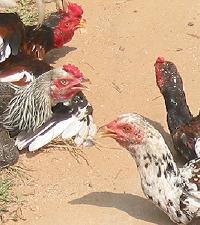Bird flu kills 7-year-old Indonesian girl
A 7-year-old girl has died of bird flu, a health official said Friday, citing local tests, as a spike in human cases has put Indonesia on pace to soon become the world's hardest-hit country. The World Health Organization has yet to confirm the death, which would bring the country's official death toll from the H5N1 virus to 37.

The girl, from Pamulang on the outskirts of Jakarta , died late Thursday after apparently coming into contact with sick poultry, said Nyoman Kandun, a senior Health Ministry official. The girl's 10-year-old brother died three days earlier with similar flu-like symptoms, but no samples were taken, said Dr. Hariadi Wibisono, a director at the ministry. The boy died in an emergency room before being treated, and the family immediately took him home for burial, he said.
"The family reported that chickens died near their house, and we have been told they had contact with birds," Wibisono said. The children's father said he was aware of bird flu, but had no idea the virus was circulating near the family's house.
"I am very shocked. I do not understand how bird flu occurred in my neighborhood," said Suryoto, who like many Indonesians uses only one name. "This internationally known disease took away my lovely children only in days, less then a week." He said his son fell ill with a fever after playing soccer with other children near their home. When it became difficult for the boy to breathe, Suryoto rushed him to a hospital, but it was too late.
"He died before the doctor could do something for him," Suryoto said, adding his three surviving children were all healthy. Meanwhile, Bayu Khrisnamurti, secretary-general of the National Committee of Avian Flu Control, said a mass poultry slaughter would begin soon in the North Sumatra village of Kubu Simbelang .
The village attracted international attention last month after six members of a family died of bird flu and a seventh was sickened. An eighth family member was buried before samples were collected, but WHO considers her part of the cluster of cases the largest ever reported. Experts have not found any link between the relatives and infected birds, which has led them to suspect human-to-human transmission. But no one outside the group of blood relatives has fallen ill and experts say the virus has not mutated.
Bird flu has killed at least 127 people worldwide since it started ravaging Asian poultry farms in late 2003. It is difficult for humans to catch, but experts fear the virus could mutate into a form more easily transmissible between humans, potentially sparking a pandemic. So far, most human cases have been linked to contact with infected birds. Indonesia has seen an explosion in human bird flu deaths one every 2 1/2 days on average last month alone putting it second behind only Vietnam, where 42 people have died.
"This virus is clearly entrenched in backyard chickens, and that means that virtually anyone who has birds in their yards could be at risk," said Steven Bjorge, a WHO epidemiologist in Jakarta . Tri Satya Putri Naipospos, chair of the directive board at the Center for Indonesian Veterinary Analytical Studies, said the government must make slaughtering sick chickens a priority to gain ground against the virus.
"This government has never ever given any priority to veterinary matters," said Naipospos, who was fired in 2005 for going public with how severe the bird flu situation was in Indonesia . She was rehired in February and appointed to the center. "The virus is still out there and there is no means to stop it," she said. "We cannot get away from this disease without first doing something with the chickens. So, we've urged the government to say that control at the source is the main priority."
In Rome on Thursday, the U.N. Food and Agriculture Organization said it was considering a US$6.8 million (euro5.3 million) plan to outfit some wild birds with tiny backpacks to monitor their annual migrations. The project would rely on communications satellites and a network of computers to track the birds' movements and ultimately help experts gain more information about the spread of bird flu. "All we have now is a snapshot. We need to see the whole film," said Joseph Domenech, the organization's chief veterinary officer, reports the AP.
N.U.
Subscribe to Pravda.Ru Telegram channel, Facebook, RSS!


